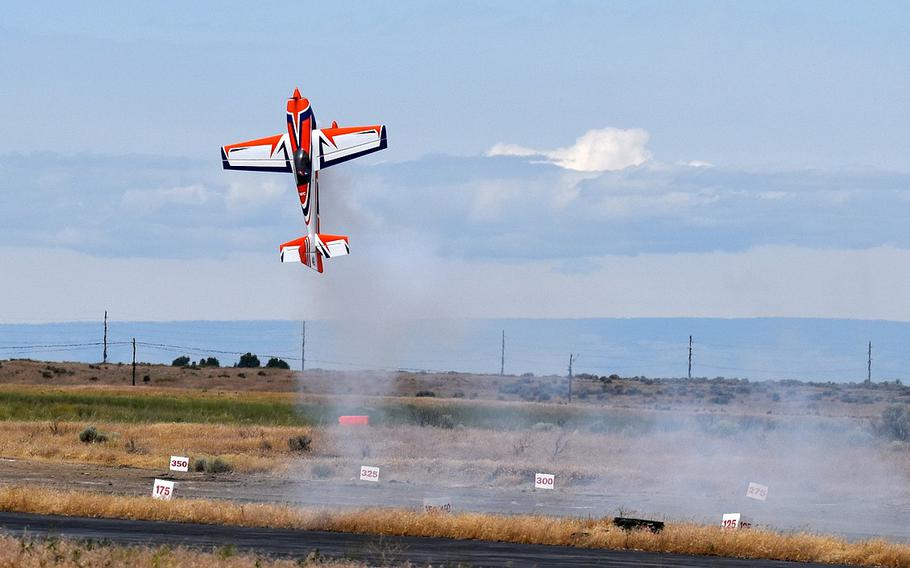
A radio-controlled plane appears to hover above the tarmac at the Moses Lake Airshow Friday. (JOEL MARTIN/COLUMBIA BASIN HERALD)
(Tribune News Service) — The wind wasn’t powerful at the Grant County International Airport on Saturday — just enough to make papers blow around and sweep the occasional hat away — but it was enough to make some pilots happy.
“We’re all excited about the wind, because it can really make for a fun competition,” said Jeff Vallon of San Francisco, who was at the Moses Lake Airshow for the STOL, or short takeoff and landing, competition on June 20 and 21.. “Rather than it being like a spread of like 25 feet between each landing, it’s only a 2- or 3-foot difference. And we can put on a good show for the crowd, too.”
The crowd didn’t lack for good shows. Between the STOL competition, the World RC Invitational for radio-controlled planes, static displays of aircraft of all sizes, stomach-lurching aerobatic stunt shows and an Air Force parachute drop, there was always something happening.
The air show was the host for the fifth leg of the National STOL competition, in which pilots of small planes compete to see who can take off and land in the shortest space. STOL announcer Cam Walton said the skill is useful for places like Alaska and South Africa where roads are in short supply and a bush pilot might be the only person who can take goods and people in and out of the area. A good STOL pilot can take off and land within about 200 feet, Walton said.
“It’s all about three things: wing size, weight and horsepower,” Vallon said. “If you have the (best) of all those three, most likely you’re going to be ahead.”
Vallon’s plane, called “Lil Rabbit,” didn’t have a huge engine — only 80 horsepower — but it weighed only 580 pounds, as much as a medium-sized motorcycle. A somewhat larger plane, a few parking stalls away, only weighed about 1,200 pounds, he said.
“These airplanes are (like) unfolded 7-Up cans,” Vallon said. “It’s just like paper.”
It takes a certain kind of personality to fly the STOL planes, Vallon said, like the barnstormers of the early days of aviation, where stunt pilots would perform tricks.
“We’re like sky cowboys,” he said. “I was out in a field where they stacked a story and a half of hay, and I’m out there just slaloming for no reason. And then the levee’s over here and you’re down in the bowl and then you shoot up over the levee and there’s always some fisherman (shrieking in surprise). It’s great fun.”
The RC plane enthusiasts, a little way down the tarmac, were putting their planes, most of them about four feet long, through loops and stalls that seemed to defy the laws of physics.
“If you watch the full scale (stunt pilots), you’ll see some of the maneuvers that we do, they’re going to do, but not to the same tightness,” said RC enthusiast Gale Vasquez of Moses Lake. “It’s really eye-hand coordination. Kids these days, young kids playing video games, are really picking this up quick. We know guys who started out when they were 5 years old flying a plane this size, and they’re getting so good.”
The static displays included several small, privately-owned planes as well as the Big Bend Community College aviation program’s craft. Among the displays was a replica of the Miss Veedol, which made the first nonstop flight from Japan to the United States in 1931. Miss Veedol was piloted on that flight by Clyde Pangborn, a Douglas County, Wa., native, and the flight ended in East Wenatchee, Wa.
The original Miss Veedol was lost somewhere in the Atlantic the following year, said Greg Brizendine of the Spirit of Wenatchee Project, a group of volunteers who created the replica as a way of spreading awareness about central Washington’s contribution to aviation history.
“It’s as exact as we could research,” Brizendine said. “Same plans, same materials, same engine. The Pratt and Whitney they had was a 430-horse and this is a 450-horse. But there’s really no difference.”
Airplane engines in the 1930s used automotive fuel, he explained, and the replica engine is designed to work with the higher-octane fuel used by modern planes.
The Wings of Blue, the U.S. Air Force’s parachute team, made their entrance from 5,000 feet, jumping out of a C-17, performing aerial maneuvers in free fall at speeds in excess of 120 miles per hour. They towed behind them the flags of the branches of the armed forces, as well as a POW/MIA flag and finally a U.S. flag. The jump was followed by the National Anthem and a prayer in memory of Million Air owner Larry Godden, a strong supporter of Moses Lake aviation, who passed away in January.
Alongside the grounded aircraft were display booths from different military branches as well as the Civil Air Patrol and Junior ROTC. There was a tent set up with children’s activities and a long row of food vendors of all kinds.
In all, about 3,000 visitors came out to see the Moses Lake Airshow, according to the show’s social media manager, Lynnsey Evans.
“We’re just excited to be able to get people out here and hopefully interested in aviation,” said the air show’s executive administrator, Katey Kimbrel. “Put some new blood into this and get the community here.”
© 2025 the Columbia Basin Herald, Wash.
Visit www.columbiabasinherald.com.
Distributed by Tribune Content Agency, LLC.